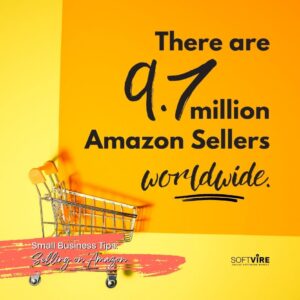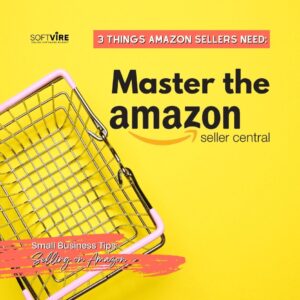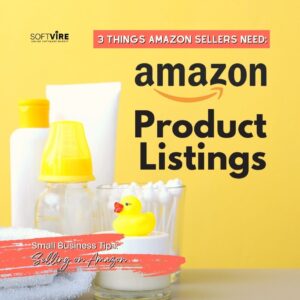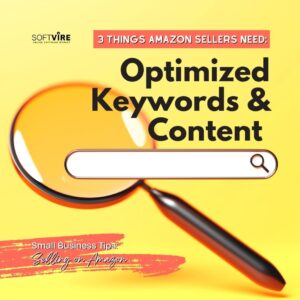Are you aspiring to sell on Amazon? For aspiring business owners and business enthusiasts, you may be wondering if your small business can find its place in the busy world of Amazon where digital and traditional markets are merging quickly.
As this global internet juggernaut reshapes how we buy and sell, savvy small business business owners naturally explore possibilities for new success. This practical guide provides small business tips covering the complexities of selling on Amazon.
Sell on Amazon: Discovering the Potential for Small Businesses
With its huge client base and user-friendly logistics, Amazon stands out among business opportunities today.
Millions of vendors make Amazon a successful marketplace. Currently, Amazon has 9.7 million sellers worldwide, out of which 1.9 million are active sellers.
In reality, over 14,000 Australian businesses, largely Small to Medium-sized Businesses or SMBs, sold about 27 million units on Amazon in a 12-month period—or around 50 units every minute. Over 3000 of these sellers are based outside major cities, including regional Australia.
However, selling on Amazon with success comes with benefits and pitfalls.
So, can your small business thrive and sell on Amazon? Let’s look into the strategies, challenges, and wins you can encounter when you sell on Amazon, from setting up shop to navigating algorithms that determine product visibility.
Let’s discover what Amazon can do for small businesses in Australia and beyond.
What You Must Know Before Diving into Amazon Sales
First and foremost, you’ll need to sign up and open an Amazon account. Amazon offers two selling plans: “Individual” (standard) and “Professional” (premium), allowing you to sell a single item or multiple products.
You need to choose the plan that suits your business before getting started with the registration process.
- Professional Plan: requires a monthly fee of $39.99, regardless of the number of items sold.
- Individual Plan: charges $0.99 per sale. If your monthly sales exceed 40 items, consider upgrading to the Professional plan.
Don’t worry about choosing the wrong plan because you can switch between them. Keep in mind that both plans involve additional fees so you can sell on Amazon.
Essential Requirements for Registration
Before completing your registration, ensure you have the following:
- Bank account details (account number and routing number)
- Credit card for charges
- Government-issued national ID
- Tax information
- Contact phone number
Understanding the Costs of Selling on Amazon
Your selling fees may vary depending on your selling method and product type.
- Subscription Fees: These correspond to your selling plan. The Professional plan costs $39.99 per month, while the Individual plan charges $0.99 per item sold.
- Selling Fees: These apply to each sold item and encompass referral fees (a percentage of the selling price, varying by product category) and variable closing fees (exclusive to media categories).
- Shipping Fees: When handling your own shipping, you’ll pay Amazon’s rates, depending on the product type and chosen shipping service.
- FBA Fees: For products fulfilled by Amazon (Fulfillment by Amazon or FBA), fees encompass order fulfillment, storage, and additional services.
Sell on Amazon: Tips for a Strong Start
Embarking on your journey as an Amazon seller is an exciting venture, but it comes with its own set of challenges and opportunities. To help you navigate this dynamic marketplace and set a strong foundation for your small business, here are essential tips for a successful start on Amazon:
1. Master Seller Central
As a new Amazon seller, your Seller Central account is your command center, your control panel for managing every aspect of your Amazon business. This platform streamlines various tasks, making it indispensable for your success.
- Sales Management: Use Seller Central to monitor your sales, track your revenue, and manage your orders efficiently. It’s your dashboard for staying on top of your business’s financial health.
- Inventory Updates: Keep your product inventory up to date with ease. Seller Central lets you manage your stock levels, ensuring that you’re always ready to fulfill orders promptly.
- Payment Processing: Handle payments securely through Seller Central. You can view transactions, issue refunds, and keep your financial records organized.
- Access Valuable Resources: Within Seller Central, you’ll find a treasure trove of resources to help you learn and grow as a seller. Explore seller forums, educational content, and reports to gain insights into your business’s performance.
2. Efficient Product Listing
Before you can start selling on Amazon, you’ll need to create compelling product listings. Here’s how to get started:
- Match or Create Listings: If you’re offering a product already available on Amazon, you can either match it to an existing listing or create a new one if you’re the first seller. The choice depends on whether there’s an existing listing for your product.
- Product ID Requirement: Many products require a Global Trade Item Number (GTIN), such as a UPC, ISBN, or EAN. These codes help Amazon identify your product accurately. Existing listings typically include this information, but for new products, you may need to obtain a UPC code or request an exemption.
- Craft Effective Listings: Your product listings are your virtual storefront. Make them stand out by creating clear, informative titles, using high-quality images that showcase your products, and providing concise, engaging bullet points. These elements make your offers more discoverable and appealing to potential customers.
Sellers upload and list their products in different ways, depending on how they plan to sell them. Simply put, professional seller accounts let sellers list their products all at once using bulk uploading or inventory management with third-party systems, while individual seller accounts let sellers list products one at a time.
Once your product is successfully listed, both B2C and B2B customers will be able to buy it. This lets you reach more people with your offers while keeping a single account and not paying any extra fees.
3. Optimize Keywords and Content
Beyond the basics of listing creation, it’s vital to optimize your product listings with relevant keywords and engaging content. This ensures that your products show up in Amazon’s search results and resonate with potential buyers.
- Keyword Research: Invest time in researching keywords that are relevant to your products. Understand what terms customers might use when searching for items like yours. Tools like Amazon’s keyword research tool and third-party options can be immensely helpful.
- Keyword Placement: Strategically incorporate these keywords into your product titles, descriptions, and bullet points. This will improve your listing’s visibility and relevance when customers search on Amazon.
- Engaging Descriptions: Write engaging and informative product descriptions that not only describe the features but also highlight the benefits. Use language that resonates with your target audience and persuades them to make a purchase.
By focusing on these crucial aspects of your Amazon journey, you’ll be better equipped to set your small business on a path to success in the highly competitive e-commerce landscape.
Pitfalls in Your Amazon Product Launch
When the listing goes well, the launch goes well, too. Following best practices for adding listings can make a big difference in how well they do. Make it easy for customers to find your offers by giving them clear titles, images, and bulleted lists of features. Things you should not do that could hurt your launch are:
- Problems with Variations: Products that only differ in size, color, or smell could be listed as variations. Think about whether the customer would expect to see all of the products on one page. If not, put them on separate lists.
- Conformity of the Image: Images must be at least 500 x 500 pixels in size (high-quality listings can be up to 1,000 x 1,000 pixels) and set against a plain white background. The product should take up at least 80% of the image area.
- Identifiers for Products: Make sure that the UPCs and GTINs (Global Trade Item Numbers) for your products are up-to-date. Because these codes are always the same, you can trust that the products in the Amazon catalog are what they say they are.
Navigating Your Amazon Business Journey
As an Amazon seller, one of the fundamental decisions you’ll face is how to deliver your products to customers effectively. Amazon offers two primary order fulfillment methods, each with its unique advantages and considerations. Let’s explore these options to help you make an informed choice:
1. Merchant Fulfillment
This involves storing and shipping products independently. Amazon refunds shipping costs, but individual plan items have fixed shipping rates.
Advantages:
- Independence: Merchant fulfillment provides you with full control over storing, packaging and shipping your products. You maintain autonomy over your inventory and fulfillment processes.
Considerations:
- Shipping Costs: As a merchant fulfiller, you are responsible for shipping costs. These costs can vary based on factors like package size, weight, and delivery destination. However, Amazon does provide a platform for purchasing and printing shipping labels at discounted rates.
- Shipping Rates: If you choose the individual selling plan, your shipping rates for each item are fixed. It’s important to evaluate whether these rates align with your pricing strategy and profit margins.
2. Fulfillment by Amazon (FBA)
FBA means Amazon packages, labels, and ships products for FBA sellers, streamlining the process.
Advantages:
- Streamlined Operations: FBA takes the burden of order fulfillment off your shoulders. Amazon handles storage, packaging, labeling, and shipping on your behalf. This can free up your time to focus on other aspects of your business, such as sourcing products and marketing.
- Prime Eligibility: Products fulfilled by Amazon through FBA are often eligible for Amazon Prime, which can attract more customers and potentially lead to higher sales volumes.
- Customer Trust: Many Amazon customers trust FBA orders due to the reliability and consistency of Amazon’s fulfillment services. This trust can lead to improved customer satisfaction and repeat business.
Considerations:
- Fulfillment Fees: FBA services come with fulfillment fees, which include storage fees, order handling fees, and pick and pack fees. These fees can vary based on factors like the size and weight of your products. It’s crucial to factor these fees into your pricing strategy.
- Inventory Management: While FBA handles storage, you must monitor your inventory levels to ensure products are available for sale. Running out of stock can impact your sales and rankings.
- Long-Term Storage Fees: FBA assesses long-term storage fees for products stored in their fulfillment centers for an extended period. Effective inventory management is key to avoiding these fees.
Choosing between merchant fulfillment and FBA depends on your business model, the type of products you sell, your available resources, and your desired level of involvement in the fulfillment process. Some sellers opt for a combination of both methods to diversify their fulfillment strategies.
Ultimately, the choice you make should align with your business goals and your ability to provide exceptional customer experiences. Whichever route you choose, meticulous planning and attention to detail are essential to your success as an Amazon seller.
Your First Sale and Beyond
Your initial sale is just the beginning. Here’s what you should keep in mind:
1. Monitor Performance Metrics
Amazon places a high emphasis on maintaining high standards to ensure a seamless customer experience. To uphold these standards, it’s essential to monitor and manage key performance metrics, including the following:
- Order Defect Rate: This metric measures how well you take care of customers. It includes factors like negative feedback, A-to-Z Guarantee claims, and credit card chargebacks. Aim to keep your order defect rate below 1% to maintain a healthy seller account.
- Rate of Canceled Orders: Excessive order cancellations can harm your seller’s reputation. Avoid canceling orders whenever possible and provide accurate information about product availability.
- Orders Shipped After the Expected Date: Timely shipping is crucial. Strive to ensure that orders are shipped promptly and meet or exceed the estimated delivery dates to maintain customer satisfaction.
You can monitor your progress in meeting these metrics through Seller Central. Consistently meeting Amazon’s performance standards is essential for maintaining a good standing on the platform.
2. Cultivate Customer Feedback
Customer reviews play a pivotal role in the success of your Amazon business. Positive reviews can boost your product’s visibility and credibility. Here are some strategies to encourage more product reviews within Amazon’s guidelines:
- Provide Excellent Customer Service: Deliver exceptional customer experiences by responding promptly to inquiries, addressing issues professionally, and ensuring that products arrive in excellent condition and on time.
- Follow-up with Buyers: Reach out to buyers with polite and non-intrusive follow-up emails, expressing gratitude for their purchase and kindly requesting feedback. Amazon allows you to use the “Request a Review” button in Seller Central for this purpose.
- Deliver Quality Products: Consistently provide high-quality products that meet or exceed customer expectations. Happy customers are more likely to leave positive reviews.
Remember to adhere to Amazon’s guidelines and policies regarding communication with buyers and review solicitation. Avoid any practices that could be seen as manipulating or incentivizing reviews, as these can result in account suspension.
3. Explore Growth Opportunities
To expand your Amazon business and reach a wider customer base, leverage the following growth opportunities:
- Amazon Advertising Solutions: Amazon offers various advertising options, such as Sponsored Products, Sponsored Brands, and Amazon Stores. These tools enable you to promote your products, increase visibility in search results, and drive more traffic to your listings.
- Global Expansion: Consider selling internationally through Amazon’s Global Selling program. Expanding to new markets can provide access to millions of potential customers and significantly boost sales. However, be prepared for the complexities of selling across borders, including language, currency, and tax considerations.
- Amazon Business: Amazon Business is a separate marketplace tailored for B2B (business-to-business) customers. It allows you to reach both B2C (business-to-consumer) and B2B customers with your listings. This dual exposure can help diversify your customer base and increase sales opportunities.
By actively monitoring your performance metrics, nurturing positive customer feedback, and exploring growth avenues, you can sell on Amazon effectively and position your Amazon business for long-term success.
Remember that building a successful Amazon business takes time and dedication, so stay committed to providing exceptional products and service to your customers as you continue to grow and evolve in the e-commerce landscape.
Qualities of a Successful Amazon Seller
Time is a precious commodity in the world of e-commerce, and your early days as an Amazon seller are crucial for establishing a strong foothold in this competitive marketplace. To help you make the most of this critical period, Amazon’s data scientists recommend a set of essential steps that can pave the way for your success:
- Brand Registry: Building a recognizable brand on Amazon is paramount for long-term success. Amazon’s Brand Registry program empowers sellers to protect their intellectual property, create a branded shopping experience, and unlock tools that enhance brand visibility. By registering your brand, you gain more control over product listings and can utilize enhanced brand content to captivate customers with immersive brand stories and engaging visuals.
- A+ Content: Elevate your product listings with A+ Content, formerly known as Enhanced Brand Content (EBC). This feature allows you to enhance your product detail pages with visually compelling multimedia elements, including images, charts, and product comparison tables. A+ Content provides a richer, more informative shopping experience for potential buyers, helping you stand out and build trust with your audience.
- FBA: Consider enlisting Amazon’s Fulfillment by Amazon service to streamline your order fulfillment process. With FBA, Amazon takes care of storage, packaging, and shipping on your behalf, allowing you to focus on other critical aspects of your business. Customers also benefit from Amazon Prime eligibility, potentially leading to increased sales and improved customer satisfaction.
- Automated Pricing: Effective pricing strategies are essential to sell on Amazon, stay competitive, and maximize your profitability. Automated pricing tools on Amazon can help you adjust your prices dynamically based on various factors, such as market conditions, competitor prices, and demand fluctuations. These tools ensure that your products remain competitive while optimizing your margins.
- Advertising: To expand your reach and drive more traffic to your product listings, consider utilizing Amazon’s advertising solutions. Amazon offers several advertising options, including Sponsored Products, Sponsored Brands, and Amazon Stores. These advertising formats enable you to promote your products in search results, on product detail pages, and even through custom brand stores. By strategically investing in advertising, you can increase your product visibility and drive sales.
Successful Amazon sellers understand that these five steps are not isolated strategies but interconnected components of a comprehensive growth strategy. By integrating these qualities into your Amazon selling approach, you can accelerate your business’s growth and build a lasting presence in the world’s largest online marketplace.
Remember, when you sell on Amazon, the first 90 days of your Amazon seller journey are a crucial opportunity to establish your brand, optimize your product listings, and fine-tune your operations. Embrace these qualities, stay adaptable, and continuously strive for improvement to thrive as an Amazon seller in the ever-evolving e-commerce landscape. Your dedication to these core principles can pave the way for sustained success on Amazon.
READ MORE: Beginner’s Guide to Online Small Business Websites
Conclusion
To sell on Amazon means you open up a huge potential to boost your business. Effective product selection, competitive pricing, and outstanding customer service can help you thrive in the global online marketplace and increase your business’ resilience in this ever-changing e-commerce landscape.
Ready to sell on Amazon, kickstart your seller journey, and supercharge your small business? Start by signing up on Amazon Seller Central and harnessing the power of e-commerce.
Just as Windows Server Essentials provides a robust foundation for your IT infrastructure, selling on Amazon offers a similarly robust platform to build your online business.
With Windows Server Essentials, you can ensure seamless and secure data management, making it easier than ever to keep track of your inventory, customer data, and financial records—essential components to sell on Amazon. Don’t miss out on the opportunity to reach millions of customers worldwide. Your path to Amazon success, with the support of Windows Server Essentials, begins now!








